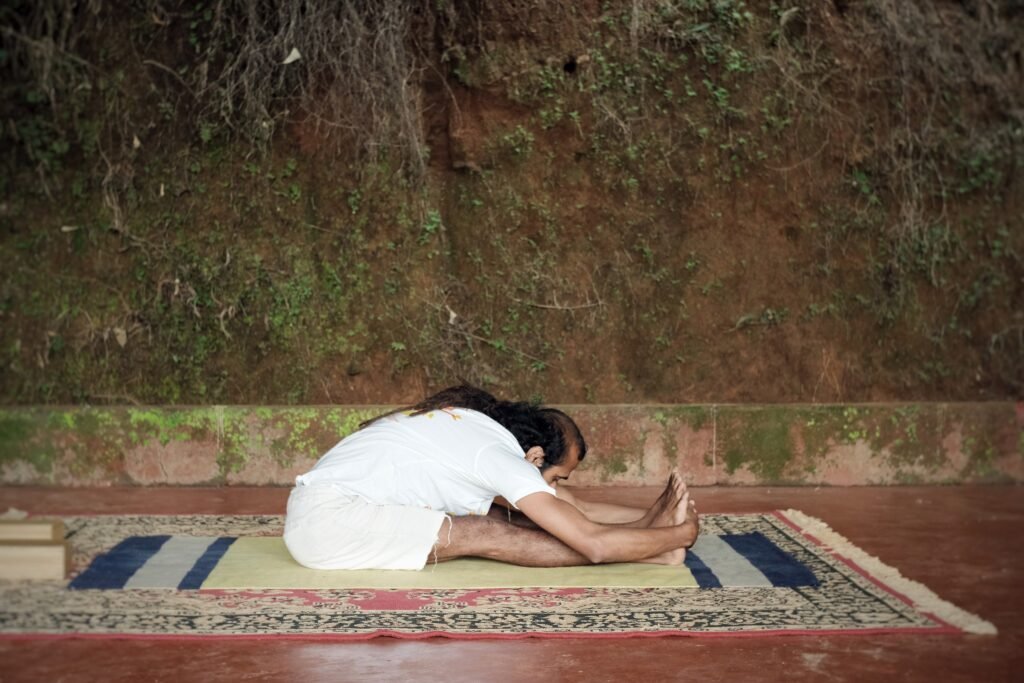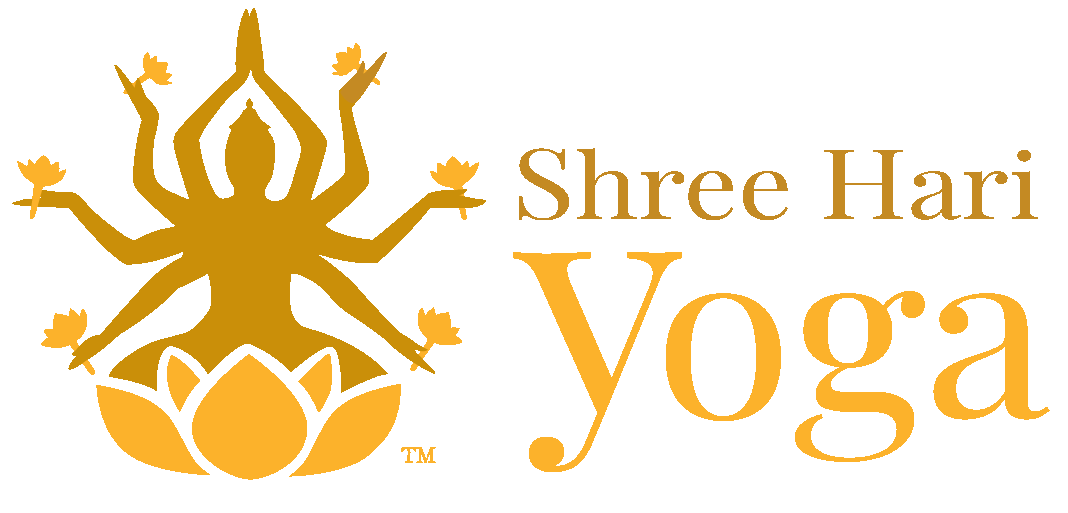
The seated forward bend pose known as Paschimottanasana (also known as “Seated Forward Bend Pose”) has the upper body folded forward over the legs and the forehead resting on the knees or below by bending the arms and gripping the wrists beyond the outstretched feet.
Paschim means “west,” but in this context, it refers to the intense stretching of the entire body’s back.
In Paschimottanasana, leaning forward is equivalent to bowing and humility, denoting graceful retirement. This also assists in balancing the chakras and opening up the body’s energy channels, which all encourage us to draw energy from within and awaken our inner being.
Seated Forward Fold Pose is a beautiful way to practice Pratyahara, the fifth limb of yoga, which entails turning your attention inward and withdrawing your senses from the outside world.
Additionally, surrendering with each exhalation aids in a small amount of tension release, bringing the brain and heart to a restful state.
STEPS FOR PASCHIMOTTANASANA:
- Reaching the ceiling, extend your arms straight to the sides. As you inhale, lengthen your spine.
- Begin to move forward while hunching at your hips as you exhale.
- Think of your pelvis as a forward-tilting bowl of water.
- Stretch out your spine with each inhalation. To do this, you should slightly relax your forward bend.
- Dive deeper into your forward bend with each exhalation. Instead of your nose touching your knees, picture your belly resting on your thighs.
- Your spine will remain longer if you do this.
- Keep your neck as your spine’s natural extension; don’t force it to look up or let it hang completely free.
- Once your spine is fully extended, choose whether to maintain this position or allow your spine to round forward.
- Grab hold of your ankles or shins, depending on what you can reach.
- Another option is to wrap a strap around your feet. Keep your feet firmly flexed the entire time.
Benefits of Sitting Forward Bend Pose (Seated Forward Bend Pose):
- Lengthens, Strengthens, and Stretches:
The hamstrings, calves, gluteus, pelvic, and back muscles experience an intense stretch when performing Paschimottanasana, a right bend onto the outstretched legs.
The forward bend elongates the spine from the cervical to the lumbar, strengthening the back’s muscles and spine. In the final position, the wrists are gripped in front of the extended feet, supporting the shoulders and enabling the practitioner to pull the torso forward with each exhalation. This makes the spine more flexible.
Additionally, bending forward onto the outstretched legs strengthens the abdominal muscles, improving core strength, knee and hip joints, and the tissues and muscles surrounding them.
- Flexibility and range of motion:
The forward bend in Paschimottanasana opens the lower back and causes an intense stretch in the hamstrings, gluteus, hips, and lower back muscles.
With practice and longer holds, the range of motion and flexibility of the affected muscles and joints can be increased, which can help students get ready for more difficult forward bends like Wide-Angle Seated Forward Bend Pose, Single Leg Forward Bend Pose, Standing Forward Fold Pose, and similar ones.
- Chest, Diaphragm, and Breath:
When the abdominal and core muscles in Paschimottanasana are tight, breathing can sometimes be difficult. However, the students’ breathing will automatically improve when they are told to open their chest and ribcage, extend their arms, and lean forward.
Thus, maintaining a broad chest and shoulders while breathing prepares the lungs for deeper breathing.
- Focus and Awareness:
Making conscious efforts to maintain a flat back, keep the chest open, and keep the shoulders broad improves focus and memory. Basic awareness is crucial because of the intensity of this practice, which strains the spine, chest, and abdominal cavity.
They improve their breathing, maintain a light and loose body, and sharpen their focus and concentration.
- Posture and Alignment:
In the seated forward fold pose, lengthening the spine aids in improving posture by strengthening the back, spine, abdominals, and legs. Students will eventually develop a well-toned body that will reduce the hunchback caused by prolonged incorrect posture in front of work desks, tone their legs and abdomen, and burn extra fat.
Yoga instructors may consider including a partner in creative practice to help with deep shoulder opening and improve alignment and posture.
- Breath and Awareness:
All forward bend poses affect the breathing, making it deep yet soft and rhythmic, which has energizing, de-stressing, and relaxing effects.
Deep, deliberate breathing helps Paschimottanasana practitioners relax their lower back, hips, and pelvis while maintaining the natural space between their vertebrae that allows for the free flow of prana (places where unwanted energies get stored).
All these things work together to cleanse the body and allow prana (energy) to flow freely from the base of the spine to the top of the head.
Deep breathing during a forward bend promotes relaxation and calmness in the body and mind.
- Organs and Stimulation:
The liver, kidneys, ovaries, and uterus are stimulated when the chest and core are compressed to rest the forehead on the knees or below the final position. Additionally, it tones and massages the pelvic and abdominal organs, preventing them from becoming sluggish. If done frequently, it may even aid in digestion improvement.
Additionally, the intense stretching of the pelvic area increases the amount of oxygenated blood that is brought there, aiding in the efficient operation of the gonads, ovaries, and adrenal glands.
- Treatment, Recovery, and Illnesses:
The seated forward fold pose can be therapeutic when demonstrated carefully and under expert instruction. Leaning forward while keeping a flat back strengthens the lower back. It can therefore be incorporated into yoga sequences to prevent or treat minor sciatica issues and neck and shoulder pains frequently brought on by poor posture.
If the students are otherwise physically fit, the active and robust pelvic region engagement makes this practice a lovely addition for students with diabetes, hypertension, IBD (Inflammatory Bowel Disease), urinary control issues, infertility, or impotence.
- Balance and Emotions:
In Paschimottanasana, leaning forward is emotionally equivalent to bowing and humility, which signify retiring and withdrawing gracefully.
As a result, the Root Chakra, Sacral Chakra, and Manipura Chakra are better balanced and more active. These chakras encourage us to draw energy from within to awaken our inner being and balance our emotions.
Therefore, surrendering with each exhalation helps to let go of a bit of tension, lulling the mind and heart into a peaceful state.
Calming the mind and calming the nerves reduces inner agitation.
Paschimottanasana can help calm the brain when practiced regularly, relieving stress and mild depression, lowering anxiety and fatigue, and promoting sound sleep.
- Others:
This pose, used in yoga for women, will help treat menstrual disorders, especially when practiced during the menstrual cycle. This pose will relieve muscular tension in runners and athletes because of the powerful lower body stretch. This pose, used in children’s yoga, will stimulate the appetite.
This pose, which has a calming quality, can be taught to students who suffer from migraines.
- Level-up Poses:
Following the regular practice of Paschimottanasana (Seated Forward Bend Pose), the student can advance to more difficult poses such as Seated Straddle Pose, Trianga Mukhaikapada Paschimottanasana, Monkey Pose Forward Bend, or Revolved Wide Angle Forward Bend Pose.
CONTRAINDICATIONS TO PASCHIMOTTANASANA:
- Surgery and Injury:
Avoid this pose if you have a knee, hip, pelvis, shoulder, rib cage, or spine injury or recently had hip or abdominal surgery.
It is best to discourage students from practicing this forward bend if they are healing from injuries to their hamstrings, calves, ankles, shoulders, or any other ligaments or tissues.
- Strength and Weakness in the Body:
Students with weak ankles, knees, or hamstrings should be cautious when being led into this pose practice.
Even though this might not be a contraindication, caution should be exercised to prevent harm or discomfort.
This pose should be avoided by students who suffer from advanced cervical and lumbar spondylitis, slipped discs, sciatica, SI-joint instability, hernias, diarrhea, ulcers, or hypertension because the spine is being deeply lengthened.
Patients with heart conditions who have recently undergone heart surgery should avoid this pose.
- Insufficient Body-Breath Connection:
Paying attention to your breathing in this pose is essential because the bend deepens with each exhalation.
Second, it’s crucial to maintain spinal alignment without hunching because this pose aims to keep a straight back, not bend it forward.
This pose shouldn’t be encouraged in students who don’t have body-breath connections.
Even students with asthma or other respiratory conditions should begin the practice slowly and stick with it while being guided by an experienced teacher.
- Others:
Pregnant women should avoid this pose because it puts too much pressure on their abdomens.
When teaching yoga to senior citizens, yoga instructors should go slowly.
Menstruating women can still hold a pose, but they should do so with a pillow or bolster under their belly for support.
Beginners or students who lack the flexibility to sit tall with their back straight can either be supported by cushions, a folded blanket, or a block placed beneath their hips, or they can be instructed to slightly bend their knees to make their back straight before gradually straightening each leg in turn, if this is more comfortable.
If it’s challenging to reach your toes or you experience pressure, try using a strap or towel. Yoga instructors should advise students to pull the belt with their arms and resist with their feet in this position.
